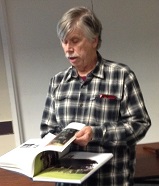Newsletter December 2019
Presidents Message
Fellow woodworkers

A. Llewellyn Poker Set
I read a section in a recent Bloomberg Businessweek "Handmade For the Holidays", not normally a section I would spend much time on but it had a picture of a 500-piece marquetry poker set in an interesting box that was worth exploring.
It was designed by Alexandra Llewellyn, a London based artist, and "consisted of more than 1000 skivers of hand cut sycamore, walnut birch and bog oak. It says she used a "process called sand shading" (which should be familiar to most of us) "Only 15 sets that are available at a price of 12,500 pounds". The boxes are made by craftsmen in small workshops in the UK.
"Even our signature designs are each touched by at least 9 workshops."
It is a beautiful box, if you read the details on her website: alexandrallewellyn.com
Bog Oak is not a wood we come across very often. It is not any specific tree but derives its name from the fact it has lain undisturbed in a peat bog for hundreds or thousands of years. Apparently a lot of Bog Oak comes from the moors of UK. Very expensive but you do not need much to add a little flavor to a box.
NOTE
As I started writing this I was not sure exactly what Bog Oak was so I typed it to my browser.
First line to come up was a list of companies offering Bog Oak for sale - no surprise.
The second line was more of a surprise:
BOG to OAK: Flights from Bogota to Oakland for 2019 | Expedia
HTTPS://WWW.EXPEDIA.COM/LP/FLIGHTS/BOG/OAK/BOGOTA-TO-OAKLAND
It might be an interesting challenge to see who can come up with airport destinations related to their Show and Tells at our future meetings!
Enjoy your woodwork Frank (Contact at: Frankramsay8@aol.com)
Top
Annual Members Meeting
The regular meeting was preceded by the Annual Members Meeting.
Financial report
Treasurer John Blackmore reported on the budget and bank account as stated in the Board Meeting held before the start of our main meeting. A copy of his financial report will be sent to members.
Election of Officers
The slate of existing Board members was read and approved to serve for another year by acclamation. They are:
Current Officers
President Frank Ramsay
Vice President Jay Perrine
Secretary Steve Rosenblum
Treasurer John Blackmore
Proof Reader Jon Kaplan
Program Director Vacant
Membership Bruce Powell
Honorary Board member Mark Rand
Honorary Board member Per Madsen
Refreshments Vacant
Shows Mike Tracy
Silent Auction Vacant
Toy Workshop Harry Filer & Frank Taylor
Note: Since the meeting we are now pleased to announce that we have a new Program Director: Paul Krentsky
Top
Last Meeting
Guests:
Guests were identified as Laura Rhodes, who has been a woodworker for 3 years and James, who is new to woodworking.
Upcoming Meetings:
December 8th: The meeting will be our annual Christmas party.
Plus our first ever Christmas Ornament Challenge which is being organized by Aaron Blohowiak
Announcements:
Bruce Powell announced the raffle of one of the walnut boards donated by the Kirks, the first and largest of 7 pieces. It was suggested
that we offer all of the remaining pieces as a unit. Bruce will consider that. Raffle tickets are $1 each or 6 for $5. The raffle will take place when $100
as been raised.
Claude Godcharles announced he had persimmons to give away at the back of the room.
John Blackmore announced that he had a bunch of used planer blades to give away that could be used as blades in homemade tools.
We are going to have our Biannual BAWA Woodworking Show again in 2020. Mike Tracy will be our show director - details to come in the new year.
At our earier Board Meeting we had a short discussion on how to attract new members. It was suggested that we look into ads on Facebook. It was pointed out that many
new members come to us via our website. The idea of mentoring new members by existing members was discussed as well as the intimidation factor of the expertise
of existing members compared to beginners. We also encourage members to suggest ideas for workshops and program presentations.
Top
Plus our first ever Christmas Ornament Challenge which is being organized by Aaron Blohowiak
Bruce Powell announced the raffle of one of the walnut boards donated by the Kirks, the first and largest of 7 pieces. It was suggested that we offer all of the remaining pieces as a unit. Bruce will consider that. Raffle tickets are $1 each or 6 for $5. The raffle will take place when $100 as been raised.
Claude Godcharles announced he had persimmons to give away at the back of the room.
John Blackmore announced that he had a bunch of used planer blades to give away that could be used as blades in homemade tools.
We are going to have our Biannual BAWA Woodworking Show again in 2020. Mike Tracy will be our show director - details to come in the new year.
At our earier Board Meeting we had a short discussion on how to attract new members. It was suggested that we look into ads on Facebook. It was pointed out that many new members come to us via our website. The idea of mentoring new members by existing members was discussed as well as the intimidation factor of the expertise of existing members compared to beginners. We also encourage members to suggest ideas for workshops and program presentations.
Top
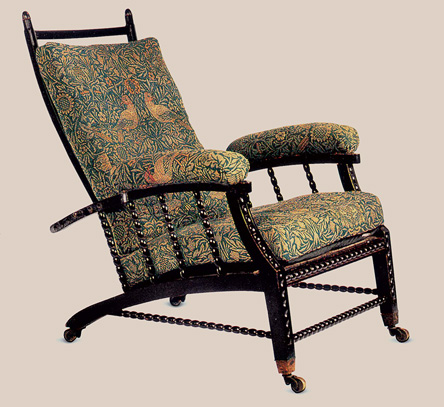
Early Morris chair

Ad for Morris chair by Stickley
Frank introduced our invited speaker, Mike Wallace whose subject is entitled "Arts and Crafts Masters".
Mike is a former officer of Sonoma County Woodworkers.
The talk deals with the Greene brothers and Gustav Stickley who were the foremost American proponents of Arts and Crafts (A&C). At the end there will be a trick question with a prize for the person with the correct answer. The A&C movement started in England with the work of William Morris and his friends A.W.N. Pugin and John Ruskin. Morris started by writing articles about furniture designed for a human scale. The first A&C house, the Red house, was built just outside London and is now owned by the National Trust. It was designed by Morris and Philip Webb. It contains a Morris chair and Morris tapestries.

Gustav Stickley
Gustav Stickley was born in Osceola, Wisconsin to German immigrant parents and was employed as a stonemason at age 12, not even finishing his elementary education. He then started work in his uncle's chair factory and became the factory manager at age 16. In 1848 he formed the Gustav Stickley Company which became United Crafts in 1901 which then became the Craftsman Workshop in 1904. Stickley used production equipment to make his products. Ideas were transferred between the US and Europe via magazines. In 1901 Stickley started "The Craftsman" magazine. The first issue was dedicated to William Morris and espoused socialist ideas. The editor was Irene Sargent of Syracuse University. Frank Lloyd Wright also contributed articles. The magazine was published from 1901-1916.
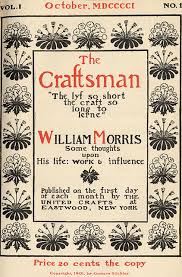
"The Craftsman"
In 1906 Stickley moved to New York City and in 1912 leased a 12-story building in Manhattan. By 1915 he had to file for bankruptcy and had to sell his home, Craftsman Farms in Parsippany, Troy Hills, New Jersey. The home was built in 1908 and sold to the Major family in 1917 who had carefully preserved it until 1989 when it was threatened by eminent domain as a hotel site and was saved by being registered as a National Historical Landmark. There is little known about Stickley from 1917 until 1942 when he died.
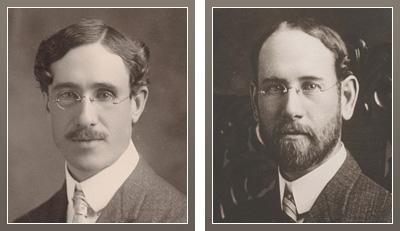
The Greene brothers
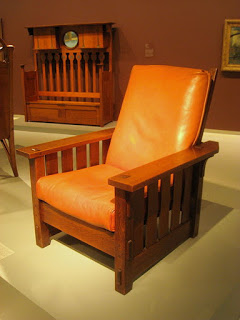
Stickily Oak chair circa 1905
Charles Sumner Greene was born in 1868 and Henry Mather Greene was born in 1870. The family can trace its roots back to early Americans Cotton Mather and Nathaniel Greene. Both brothers first attended the Manual Training School of Washington University and in 1888 attended MIT in a 2-year program in architecture where they learned Beaux Arts design. Charles was the artist and Henry was the organizer in their business ventures. Their parents moved to Pasadena in 1890 and the brothers' moved there as well in 1893. At that time Pasadena was becoming a getaway place for wealthy Americans who needed fancy homes to live and entertain in, providing the opportunity for commissions for the Greenes. They designed their first house for John Breiner in 1894, which was moved to 740 Mar Vista in Pasadena and expanded. Between 1893 and 1904 they fulfilled 103 commissions and between 1906 and 1911, 150 more.
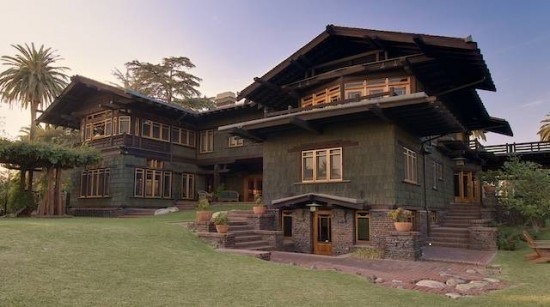
Blacker House
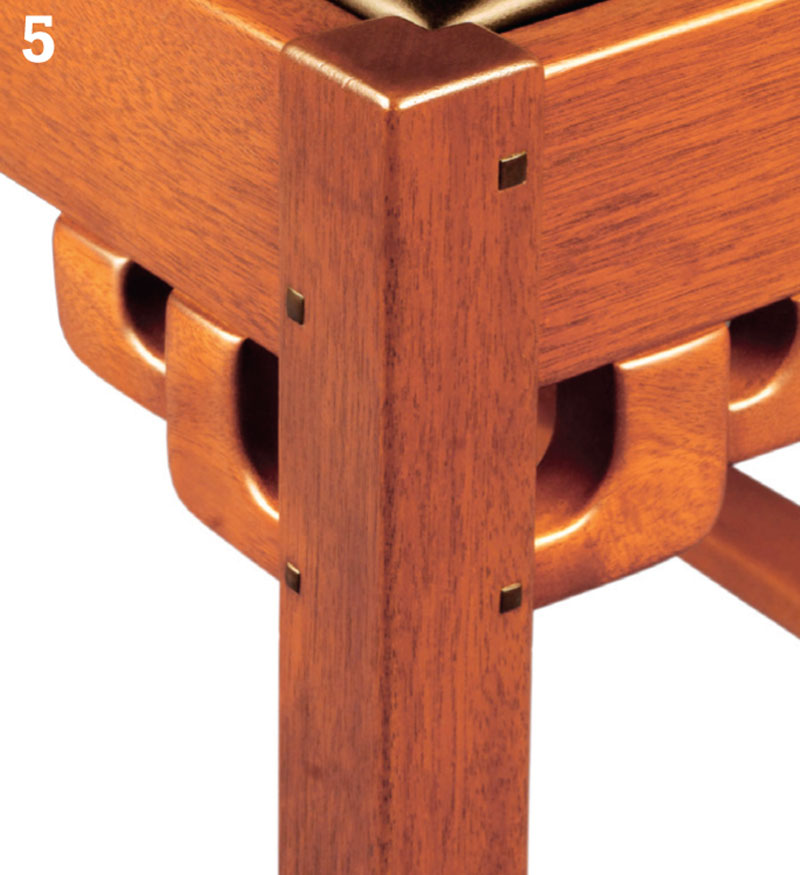
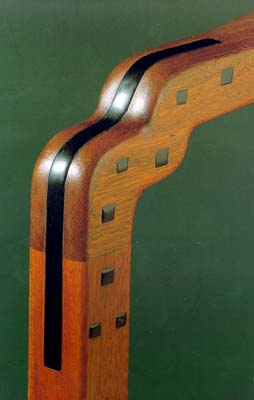
Joints of a Stickley Dinning Room Chair from the Blacker House
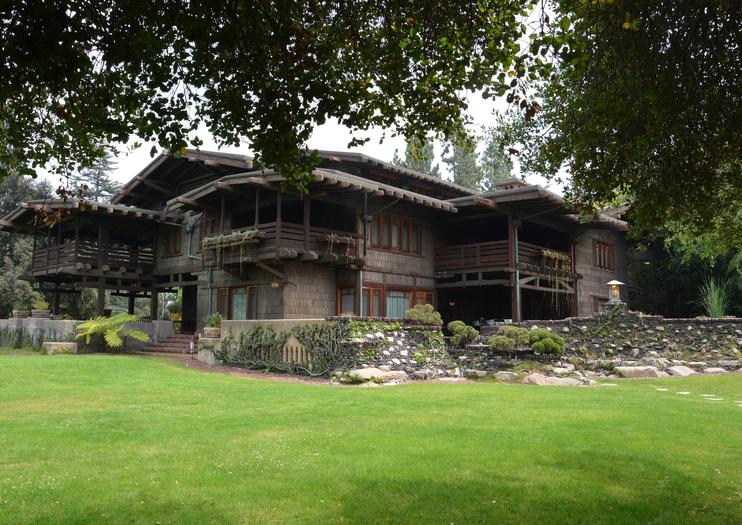
Gamble House

Lamp from the Gamble House
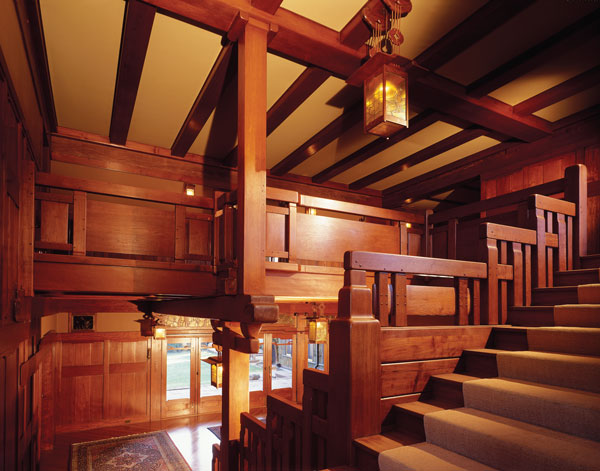
Staircase,Gamble House
Their first bungalow, Blacker House, was built at 4260 Country Club Drive, Long Beach. It preceded the Gamble House, their most famous bungalow which was designed in Feb 1908 and completed in 11 months. The commission came to the Greenes after the Gambles saw the Blacker house and were impressed by its design. Unfortunately, the people who eventually purchased the Blacker house did not like the furniture and sold it off piece by piece. The Gambles owned their house until 1966, when they bequeathed it to the USC School of Architecture. Two architecture students are allowed to live there each year. The woods used in the house are teak, maple, oak, Port Orford Cedar, and mahogany. Peter and John Hall were the master carpenters who built the house. It is the only Greene and Greene house that is still complete.
In 1922 Charles moved to Carmel and broke up the partnership. Henry died in1954 and Charles in 1957. In 1952 the brothers received a citation from the American Institute of Architects in which Stickley was not cited.
A&C furniture was manufactured in 4 different factories owned by different members of the Stickley family. It was characterized by simplicity, honesty, and exposed joinery. Henry Wilkinson was a Stickley designer from 1902-1903. Harvey Ellis was hired by Stickley in 1903 to illustrate "The Craftsman" magazine. Greene brother's furniture was influenced by Japanese design. The characteristics were cloud lifts, brackets, ebony plugs and splines, tsuba (Japanes sword hilts), and exposed finger joints. Swedish immigrants, the Hall brothers built all their furniture. An excellent book on the Greenes is "Greene and Greene" published by Phaidon, written by Edward Bosley.
Top
Show and Tell
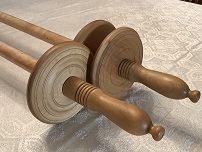
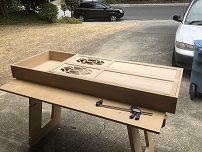
Kitchen TV cabinet
After a 15-minute break, Jon Kaplan completed the story about his construction of new torah poles for a scroll to be sent to Israel. The dowels were formed from maple plywood made by Jon. The end caps were turned on his lathe. - The end plates were formed from maple plywood made by Jon and turned on his lathe.
Jon then showed a television cabinet he designed and built for his kitchen TV. The wood was White Oak he salvaged form an office demolition. The joinery was hand cut dovetails and the decorative grilles were fabricated using his Shapeoko CNC machine.
Finally, he showed a huge slab table he saw in an office in Manhattan which was probably 50 feet long. Discussion followed about how they got it into the building.

Front door

